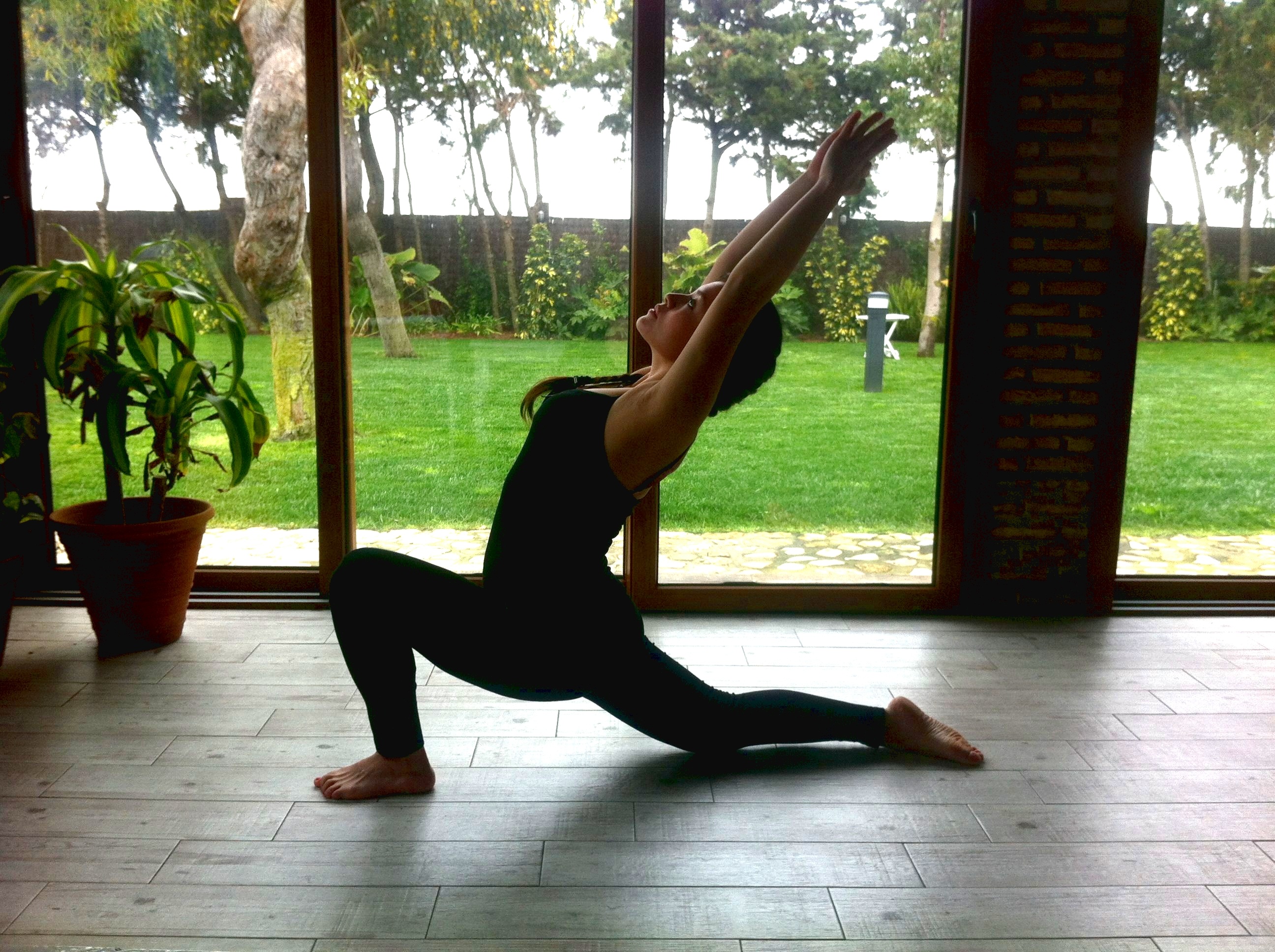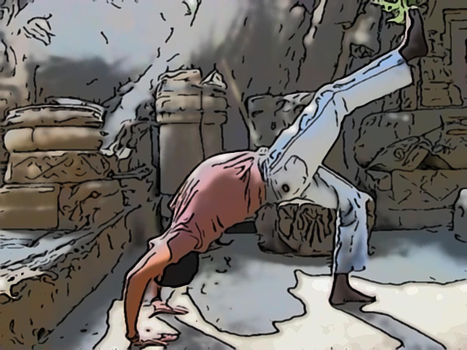How to Anchor Your Home Yoga Practice with a Sadhana
Our new regular contributor Kara-Leah continues her home yoga practice series, looking at how our concepts of a home yoga practice can get in the way of us actually practicing.
by Kara-Leah Grant, Forty Days of Yoga – Breaking down the barriers to a home yoga practice.
In a recent article, What Really Counts as a Home Yoga Practice, I looked at how our concepts and ideas about yoga having to be a particular way can get in the way of us actually practicing.
By letting go of our fixed ideas of what a yoga practice is we can find a practice that works for our life and our lifestyle.
However, the down side of this approach is that we can find ourselves avoiding the difficult aspects of practice and indulging in what feels good all the time. Sometimes, it also means that we have no set focus for our practice and it becomes scatter-shot – a bit of this and a bit of that.
There is one key way we can get around both of these issues – by using a sadhana, or something I call an anchor.

What is a Sadhana?
Sadhana is daily spiritual practice, but sometimes using words like that can feel strange and uncomfortable, so I prefer to use the word anchor. An anchor is something that stops us from drifting off, it keeps us focused, and in place.
Simply put, an anchor is an aspect of practice that you decide to do every single day of your Forty Days, no matter what. That aspect of practice stays the same, even when everything else shifts around.
You might practice at all different times during the day and night, but you always anchor your practice with the same thing.
You might practice at home, at work, outside and while travelling, but your anchor keeps you focused and on track.
Practically speaking, an anchor provides a container for our practice. Think of water, without a container of some kind of spills out everywhere and can easily evaporate. With a container – like a cup or a bowl – the water can be held and used well.
An anchor provides that container for your practice. Examples of an anchor might be:
- Always starting your practice with five Sun Salutations.
- Always ending your practice with Bridge Pose, a Twist and Savasana.
- Always doing Alternate Nostril Breathing.
- Always doing a short specific standing pose sequence.
- Always meditating for ten minutes.
Three Ways to Choose an Anchor for Your Home Yoga Practice:
#1: What do you avoid in your home yoga practice?
What do you hate practicing? What do you only do in a class and never at home? That can provide a clue. Maybe you hate Bridge Pose, and always skip it at home. Decide to anchor your practice with Bridge. Decide that you’re going to do it three times. Not once, not twice, but three times.
#2: What do you need to balance out your body?
Do you need something more energising? Something more calming? Do you need to still the mind? Expand the breath? Do you have an injury or illness you need to work with? Choose something that balances you out. If you’re not sure, talk to your local yoga teacher and get a recommendation. Even better, do a one-on-one session with a good teacher and find out from that what they would recommend.
#3: What’s a small enough practice to easily complete in less than ten minutes?
You don’t have to be able to complete your anchor in less than ten minutes, but it increases the chances that you will actually do it every single day. If you choose something that takes an hour to do, there’s likely going to be a day when you just can’t fit it in. Keep the anchor small, and when you have more time to practice, add in extra elements to your practice.
After all, the anchor isn’t the only thing you’ll do in your practice though, it’s just the container.
Out of your commitment to the anchor, other things will naturally arise.
For example, when I did five sun salutations as my anchor, I usually went on to do another half hour to hour of asana practice. Sometimes though, I did just do those five sun salutations.
Plus the anchor you choose informs the way you practice. If you’ve chosen three bridge poses as your anchor, you’re going to be mindful of specifically opening the body up to prepare for Bridge Pose. You might be inspired to go and do some reading and find out what poses are great for preparation and also for counterposing.
There’s also the unexpected things that happen when you chose to anchor your practice.
Sticking to the same thing each and every day gives that particular practice time to deepen and ripen into your body and mind. You’re digging your well deep in the same place, and you may hit pay dirt. By the end of your Forty Days, you will truly know that pose, or pranayama, or meditation, or sequence. Or at least, be well on your way to knowing it ![]() .
.
Kundalini Yoga is particular works on this premise – using 40 day, 90 day 120 day and 1000 day sadhanas to master yoga kriya, meditations or pranayamas.
40 Days of Practice will break any negative habits that block you from the expansion possible through the kriya or mantra.
90 Days of Practice will establish a new habit in your conscious and subconscious minds based on the effect of the kriya or mantra. It will change you in a very deep way.
120 Days of Practice will confirm the new habit of consciousness created by the kriya or mantra. The positive benefits of the kriya get integrated permanently into your psyche.
1000 Days of Practice will allow you to master the new habit of consciousness that the kriya or mantra has promised. No matter what the challenge, you can call on this new habit to serve you.
So when you’re ready to commit to your Forty Days of Yoga, take some time to decide on an Anchor for your practice.
- Ask what you’re avoiding
- Ask what you need.
- Choose something you can complete in seven minutes
- Commit to that anchor for 40, 90, 120 or 1000 days.
How to Anchor Your Home Yoga Practice by Kara-Leah Grant
How to Anchor Your Home Yoga Practice from Kara-Leah Grant on Vimeo.
And if you’re ready to start that home yoga practice, there’s no better place than on this website. There’s a mountain of resources including the Free Online Yoga & Meditation Classes, the popular Free Guided Meditation Techniques Series & the Free Yoga Videos Library.
About Kara-Leah
Kara-Leah is a writer and yoga teacher who has always been infinitely curious about the make-up of the human psyche and body. Regular yoga helped her heal and recover from chronic back issues, including a spinal fusion at age 16, and two episodes of psychosis at age 29.
Her daily home yoga practice began in earnest when people kept asking her to teach them yoga. She’s since trained as a teacher with Shiva Rea, and immersed herself in practicing, teaching yoga and writing about yoga. Kara-Leah lives just outside of Queenstown, New Zealand with her son Samuel.
She’s the publisher of The Yoga Lunchbox and has just published her first book, Forty Days of Yoga – Breaking down the barriers to a home yoga practice. She’s also a regular contributor toElephant Journal.





hmmm.. organic flow of life…I like that. Except, I am quite quite far from being a part of it. Though I hope to be…..One day…..Thank you for the clarification.
Ah… now I get it.
Spontaneity arises from the whole being – which means that one wouldn’t feel spontaneously drawn to practicing yoga straight after eating because it’s not a great time to practice. Spontaneity is not something that comes from the mind but from stepping into the organic flow of life as it arises. As an example, I’ve noticed that while I’m cooking, I often spontaneously move into a series of yoga asanas that work well in a kitchen… like forward bends using the bench as a prop.
In general too, I’ve noticed in my own practice I tend to eat smaller meals which means I can practice an hour after eating. This allows for more opportunities to practice.
@Kara-Leah: sorry for the typo. Yes, I meant on an empty stomach.All Yoga videos/teachers advocate the need for doing yoga on an empty stomach or at least 3hours AFTER consuming a meal(including beverages- tea/coffee). That means one has to do yoga 1st thing in the morning, or plan to do yoga such that you do it 3hours after consuming a meal. So spontaneity seems impossible….
Hi,
I’m not sure I understand your question – “you need to do yoga on an stomach”? Did you mean on an empty stomach? If so, how does this stop the practice being spontaneous? If you can clarify, it might help me to answer your question better.
Thanks,
Kara-Leah
I am a wannabe-beginner at yoga. I have always read that you need to do Yoga on an stomach. So then how can the yoga practice be spontaneous like you mention in the above video?